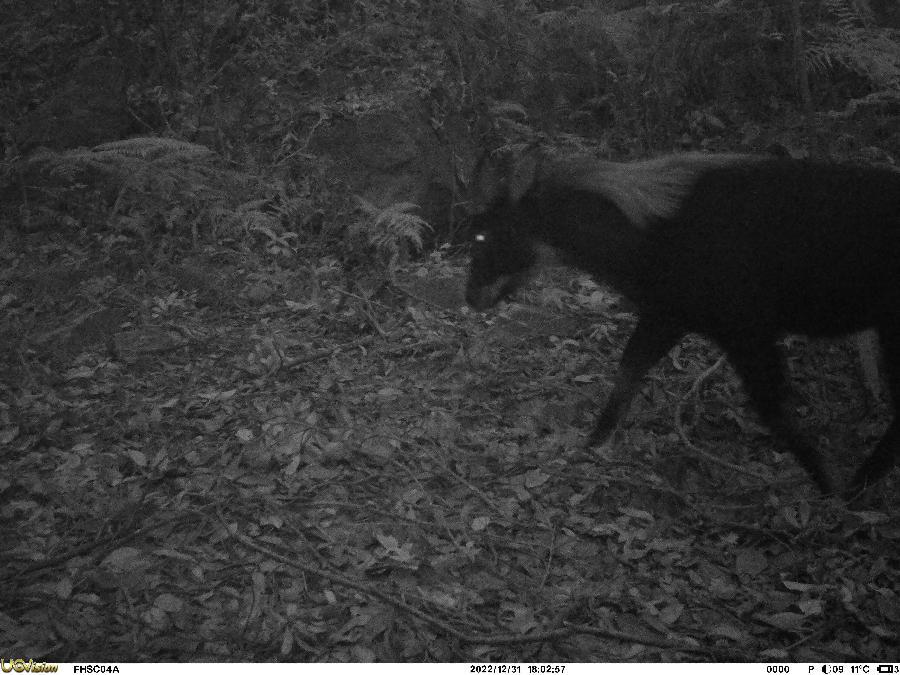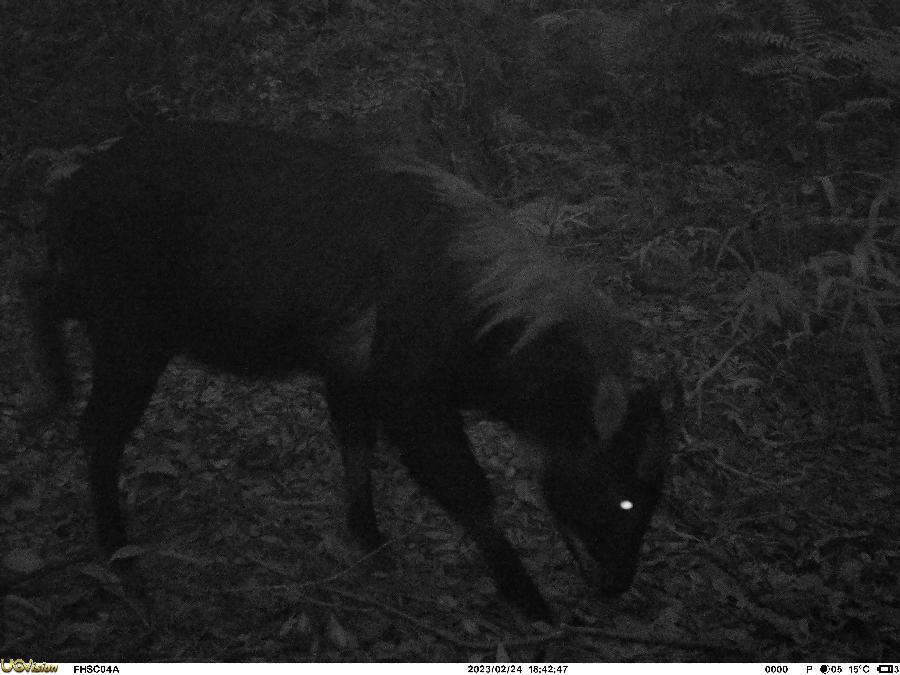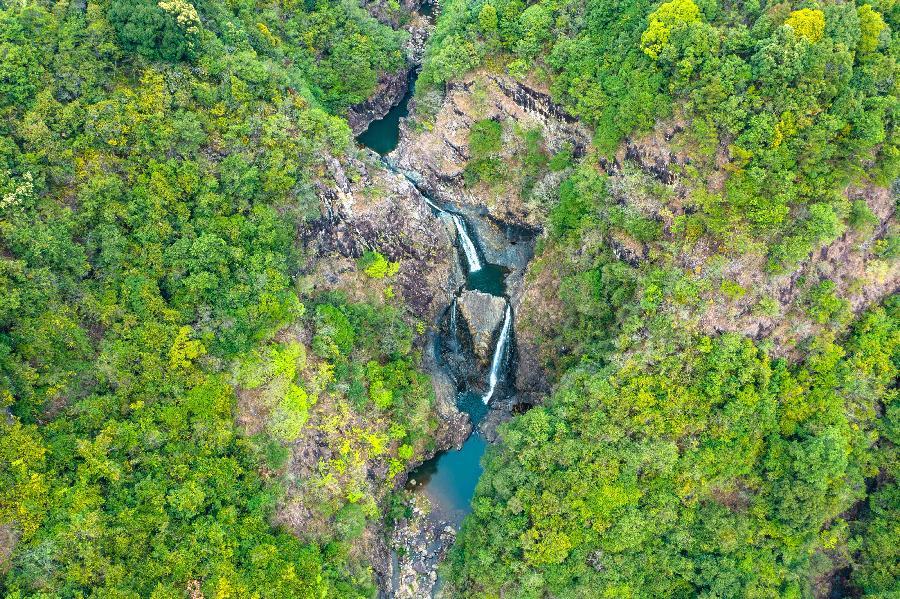
In a recent discovery, staff at the provincial-level nature reserve, Phoenix Mountain, in Chao'an, Guangdong, were thrilled to find precious footage of a mother and child Chinese Serows captured by field infrared cameras. According to the Forestry Bureau of Guangdong, this marks the first documented activity of Chinese Serow in the Phoenix Mountain Conservation Area.

Chinese Serow, also known as the "Four Unlikes," are a level 2 nationally protected species and primarily inhabit mixed needle-broadleaf forests, coniferous forests, or rocky shrub forests at elevations between 1000 to 4400 meters. They are known for their agile movements and tend to live alone or in small groups, often navigating cliff edges and rarely visited areas for foraging.
Researchers at the conservation area expressed that they retrieved data from 40 infrared cameras, with two of them capturing multiple instances of Chinese Serow activity. One video clip reveals a mother serow leisurely strolling through the forest with her adorable offspring closely following - a heartwarming sight.

"Chinese Serows have a strong sense of territory and usually prefer solitary activities. Apart from the mating season, males tend to live alone, while females cohabitate with their offspring," explained Hu Huijian, a researcher at the Guangdong Academy of Sciences. The recorded young Chinese Serow appears to be small in size, indicating it is likely still in the lactation period. Chinese Serow offspring typically leave home 1-2 years after birth, during which they learn various survival skills from their mothers.
To enhance the monitoring of dynamic information related to wildlife conservation, the Phoenix Mountain Conservation Area has deployed 50 infrared cameras across the entire region, establishing a preliminary grid monitoring system. In recent years, the conservation area has observed the dynamic presence of ten nationally protected wildlife species, including Chinese pangolins, Chinese Serows, and leopard cats.

In recent years, Chaozhou has intensified efforts to protect biodiversity, establishing the province's first biodiversity conservation research center. The city has also explored local legislation for biodiversity protection, formed the Chaozhou Natural Protected Area Management Center, and consistently excelled in the protection and restoration of wildlife habitats, along with increased efforts in biodiversity protection advocacy.
A survey indicates that Chaozhou currently boasts 313 terrestrial wild animal species and 2093 terrestrial wild plant species, including nationally protected wildlife such as Chinese Pangolins, Chinese Egrets, and Saunder's Gulls, as well as regionally rare and unique species like Chestnut-headed Bee-eaters.
Source :Yangcheng Evening News
中华鬣羚首度现身广东潮安凤凰山保护区
近日,广东潮安凤凰山省级自然保护区工作人员在整理野外红外相机监测数据时,惊喜地发现一对中华鬣羚母子同框活动的珍贵画面。据省林业局透露,这是凤凰山保护区首次拍摄到中华鬣羚的活动影像。
据了解,中华鬣羚又称“四不像”,是国家二级保护野生动物,主要活动于海拔1000-4400米针阔混交林、针叶林或多岩石的杂灌林,单独或成小群生活,行动敏捷。中华鬣羚生性胆小、行踪隐秘,常在悬崖峭壁或人迹罕至的地方觅食。
保护区科研工作人员表示,此次共回收了凤凰山保护区40台红外相机资料,其中两台红外相机多次拍摄到了中华鬣羚的活动影像。从其中一个视频画面可以看到,一只中华鬣羚妈妈正带着幼崽在林区闲逛,可爱的小鬣羚紧紧跟着妈妈,画面十分温馨。
“中华鬣羚的领地意识强,比较喜欢独自外出活动,除了发情期,雄性多独居,雌性则跟幼崽一起生活。”广东省科学院动物研究所研究员胡慧建介绍,本次记录到的小中华鬣羚体型较小,目测尚处于哺乳期,中华鬣羚幼崽出生1-2年后才会离家,在此之前要跟着妈妈学习各种生存技能。
据介绍,为加强对野生保护对象动态信息的监测,凤凰山保护区在全区范围内网格化布局了50台红外相机,初步建成了动物网格化监测体系。据统计,近年来凤凰山保护区相继监测到中华穿山甲、中华鬣羚、白鹇、豹猫、斑头鸺鹠等10种国家保护野生动物的动态。“这充分证明了保护区内的生态环境有了明显改善,野生动植物种群不断扩大。”该保护区科研工作人员表示。
近年来,潮州市不断加大生物多样性保护力度,成立省内首个生物多样性保护研究中心,探索开展生物多样性保护地方立法工作,成立潮州市自然保护地管护中心,持续做好野生动植物保护及栖息地保护修复,加大对生物多样性保护的宣传力度。
经调查统计,目前,潮州市拥有陆生野生动物313种,陆生野生植物2093种,包括中华穿山甲、黄嘴白鹭、黑嘴鸥等国家一级保护野生动物,栗喉蜂虎、高山棘螈、紫水鸡、潮州莸等国家二级保护野生及潮州市特有珍稀动植物。
文|新快报记者 王彤 通讯员 林荫
-
"Robots+" emerges as an accelerator for 'intelligent manufacturing'
2024-01-05 23:01:57 -
Guangdong meteorological experts assist Solomon Islands in weather observation
2024-01-05 23:01:49 -
Dance drama 'Wing Chun' premieres in Hong Kong
2024-01-05 23:01:21 -
New holiday feel brought by Cantonese New Year's dish
2024-01-04 22:43:02






